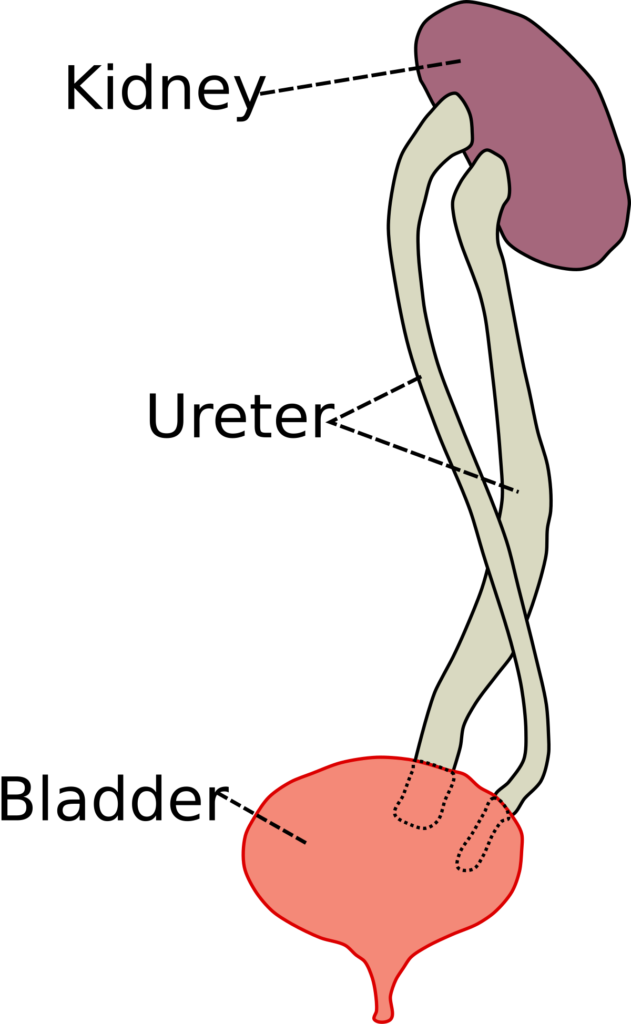
The urinary system known as the renal system, produces, stores and eliminates urine, the fluid waste excreted by the kidneys. The urinary system consists of the kidneys, ureters, urinary bladder, and urethra.
The kidney and urinary systems help the body to eliminate liquid waste called urea, and to keep chemicals, such as potassium and sodium, and water in balance. Urea is produced when foods containing protein, such as meat, poultry, and certain vegetables, are broken down in the body. Urea is carried in the bloodstream to the kidneys, where it is removed along with water and other wastes in the form of urine.
Parts of Urinary System
- Kidney (2)
- Ureters (2)
- Urinary Bladder
- Urethra
Kidney

- The kidneys are a pair of bean-shaped organs and present along with posterior wall of the abdominal cavity.
- The left kidney is located slightly higher than the right kidney because the right side of the liver is much larger than the left side.
- The kidneys, unlike the other organs of the abdominal cavity, are located posterior to the peritoneum and touch the muscles of the back.
- There are three major regions of the kidney:
- Renal cortex
- Renal medulla
- Renal pelvis
Renal cortex
- The kidneys are made by a renal cortex, a layer of tissue that is also covered by renal fascia and the renal capsule.
- The renal cortex is granular tissue due to the presence of nephrons the functional unit of the kidney that are located deeper within the kidney, within the renal pyramids of the medulla.
- The cortex provides a space for arterioles and venules from the renal artery and vein, as well as the glomerular capillaries, to perfuse the nephrons of the kidney.
Renal medulla
- The renal medulla is made up of conical masses of tissue called renal pyramids.
- The renal cortex forms a shell around the medulla. Its tissues dip into the medulla between adjacent renal pyramids to form renal columns.
- The granular appearance of the cortex is due to the presence of random arrangement of tiny tubules associated with nephrons, the functional units of the kidney.
Renal Pelvis
- The renal pelvis is present inside the renal sinus. Renal pelvis, enlarged upper end of the ureter, the tube through which urine flows from the kidney to the urinary bladder.
- The pelvis, which is shaped somewhat like a funnel that is curved to one side, is almost completely enclosed in the deep indentation on the concave side of the kidney, the sinus.
Ureters

- The ureters are two thick tubes which act to transport urine from the kidney to the bladder.
- The ureteric walls are composed of smooth muscle, which contracts to produce peristaltic waves. This propels the urine towards the bladder.
- The ureters arise from the renal pelvis. The renal pelvis receives urine from the major calyces. The point at which the renal pelvis narrows to form the ureter is known as the ureteropelvic junction.
Urinary Bladder
- The bladder is a hollow, muscular, and pear-shaped elastic organ that present on the pelvic floor. It receives urine via the ureters. Urine is collected in the body of the bladder, and finally it is emptied through the urethra.
- There is a triangular area, called the trigone, formed by three openings in the floor of the urinary bladder. Two of the openings are from the ureters and form the base of the trigone.
Urethra
- The urethra is the passageway between the bladder and the external part of the body, which allows urine to be excreted from the body.
- The urethra is held closed by the urethral sphincter, a muscular structure that helps keep urine in the bladder until voiding can occur.
- The urethra also connects the to the ductus deferens in males, for the ejaculation of sperm.
- The length of the urethra is much shorter in women than in men, due to the anatomical gender differences in the area.
- The urethra serves a double purpose in men as it also serves as a passage for semen during ejaculation when partaking in sexual activities.
